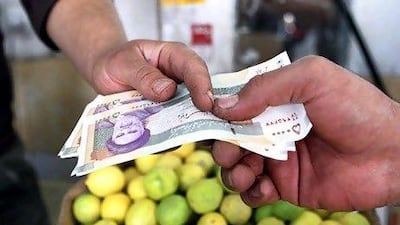A new Iranian joke has one man asking another how many rials a dollar will buy. The other replies, "You mean now … or now?" Sanctions on Iran's oil sales and mismanagement by the government of president Mahmoud Ahmadinejad have triggered a collapse in the country's currency.
Those advocating sanctions against Iran have seized on this as evidence that their policy is "working".
But the logic is incomplete. Clearly sanctions are hurting ordinary Iranians. Yet to speak of economic "collapse" is misleading. To assume that the rial's fall must pose serious political danger to the regime is even more far-fetched.
At the start of Iran's revolution in 1978, 70 rials bought one dollar. After a decade of war and two decades of sanctions, the currency had declined to about 10,000 per dollar by 1999.
From then on, increasing oil prices allowed the government to feed dollars into the economy to stabilise the exchange rate, which remained quite steady until this year, and to control domestic inflation.
This year, with Iran's oil exports cut to less than half their usual levels, the rial dropped sharply in January and again in the past few days, before recovering slightly to about 29,000 to the dollar.
The psychological impact of the rial's plunge is perhaps more important than its economic effect.
The decline has laid bare the depths of the regime's mismanagement, and made clear the costs of the nuclear stand-off. It has contributed to a deepening atmosphere of gloom and hopelessness among ordinary Iranians. And it has, unusually, brought the merchant "bazaari" class out in protest.
This might recall the eventual fall of the Soviet Union after the 1986 oil price crash, or Iraq's grim decade under embargo following the invasion of Kuwait. But this would be misleading.
Iran has little foreign debt, and surging imports have largely been modest "luxuries" for the middle class. In contrast, the Soviet Union was reliant on credits to pay for massive food imports, while Iraq was defeated, encircled and with its oil sales under external control.
The Ahmadinejad administration's handling of the economy has generally been dismal. Yet it did introduce a major economic reform, replacing wasteful energy subsidies with cash handouts, cushioning the lower classes.
Petrol imports, the sanctions lobby's topic du jour in 2010, have been largely eliminated.
Oil prices remain high, and would have been higher still were it not for the weak global economy. For the West to rely on dismal economic news to sustain oil sanctions is hardly a winning or popular strategy.
Iran's response to the sanctions has been surprisingly clumsy but, given time, it will chip away at sanctions, develop smuggling relationships, build up its tanker fleet, and arrange alternative insurance.
Once China grows accustomed to discounted Iranian oil, it will have no incentive to assist either in ending sanctions or tightening them further. Iran's other key customers, India, Japan and South Korea, will also seek to keep buying even if at somewhat reduced levels.
As long as oil prices do not fall sharply, Tehran can continue to bring in enough oil revenues to continue paying off key regime supporters. Meanwhile the West's natural allies within Iran, the urban, educated middle class, decline through destitution and emigration.
Those who reluctantly embrace economic warfare as the best alternative to bombs hope to buy time for an unspecified but positive change. But Iran's curious political system and major oil exports make it resilient even to the pressure of the slumping rial. A single number is not an explanation for how sanctions can force or persuade Tehran to the negotiating table.
Robin Mills is the head of consulting at Manaar Energy, and the author of The Myth of the Oil Crisis and Capturing Carbon


